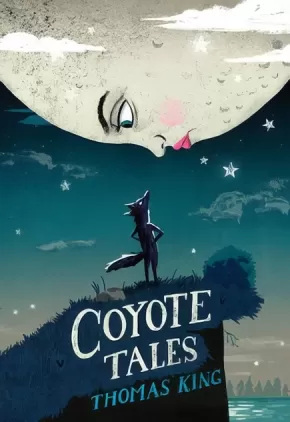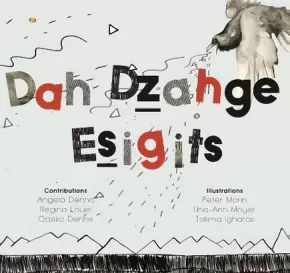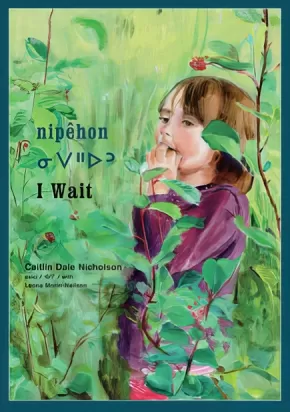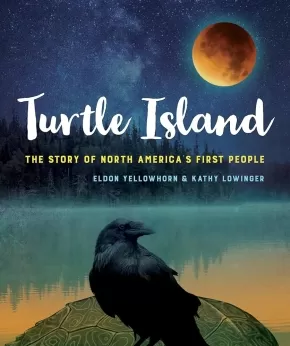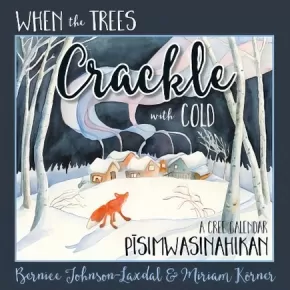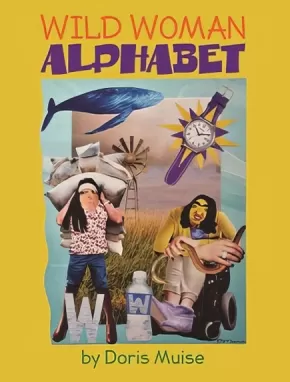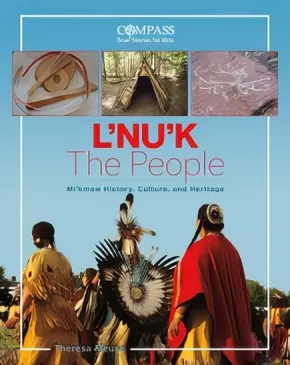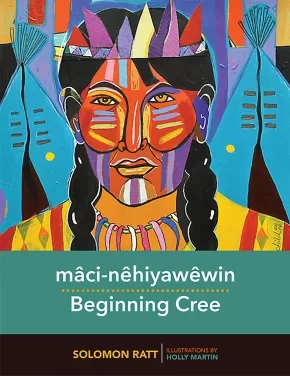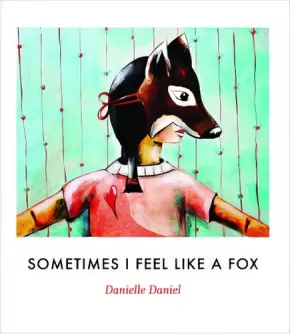
Canadian Indigenous Books for Schools K-7 2018-2019
16
-
28
of
28 Results;
Sort By
Go To
of 2
This list of Indigenous titles was published by The Association of Book Publishers of British Columbia (ABPBC) in 2018-2019.
Coyote Tales
$16.95
Artists:
Format:
Hardcover
Text Content Territories:
Indigenous;
ISBN / Barcode: 9781554988334
Synopsis:
Synopsis:
Two tales, set in a time “when animals and human beings still talked to each other,” display Thomas King’s cheeky humor and master storytelling skills. Freshly illustrated and reissued as an early chapter book, these stories are perfect for newly independent readers.
In Coyote Sings to the Moon, Coyote is at first the cause of misfortune. In those days, when the moon was much brighter and closer to the earth, Old Woman and the animals would sing to her each night. Coyote attempts to join them, but his voice is so terrible they beg him to stop. He is crushed and lashes out — who needs Moon anyway? Furious, Moon dives into a pond, plunging the world into darkness. But clever Old Woman comes up with a plan to send Moon back up into the sky and, thanks to Coyote, there she stays.
In Coyote’s New Suit, mischievous Raven wreaks havoc when she suggests that Coyote’s toasty brown suit is not the finest in the forest, thus prompting him to steal suits belonging to all the other animals. Meanwhile, Raven tells the other animals to borrow clothes from the humans’ camp. When Coyote finds that his closet is too full, Raven slyly suggests he hold a yard sale, then sends the human beings (in their underwear) and the animals (in their ill-fitting human clothes) along for the fun. A hilarious illustration of the consequences of wanting more than we need.
Reviews
"Coyote Tales features two tales crafted together to reflect on a time when animals and humans still spoke to each other. The two uniquely crafted works teach lessons and demonstrate how to think and reflect, displaying the many ways to solve problems." - The Dalai Lama Center
Educator Information
Recommended for Grades K-4 English Language Arts.
Curriculum Connections: Social Studies, Language Arts, History, Indigenous Studies.
Recommended Ages: 6 - 9.
This book is available in French: Contes de Coyote.
Additional Information
56 pages | 5.25" x 7.75"
Dah Dẕāhge Esigits: We Write Our Language
$19.95
Format:
Paperback
Text Content Territories:
Indigenous Canadian; First Nations; Dene; Tahltan (Nahanni);
ISBN / Barcode: 9781926886497
Synopsis:
Synopsis:
This beautifully illustrated book teaches the language of the Tahltan nation. The Tahltan alphabet is featured with the 47 sounds of the Tahltan language. Learners can match vowels, consonants and sounds to English equivalents and symbols. It is a resource for those who can already speak Tahltan, but wish to learn to read and write as well.
From the Preface:
The (Tahltan) Alphabet was developed by linguist Colin Carter in consultation with Tahltan speakers, Elders and language instructors...The (Tahltan) Alphabet...is phonetic, which means that every Tahltan sound is written with consistent symbols. This is different from the English alphabet where sounds can be written with various letters and combinations of them. The Tahltan alphabet is a summation of the 47 sounds of the Tahltan language. Carter and the Tahltan consultants decided to use English letters and represent specialized Tahltan sounds with more than one letter (eg dz, tl, ch) and other markings such as underlining, apostrophe and macron.
Educator Information
Recommended for Grades K-7 English Language Arts and courses in Indigenous language learning.
This book was coordinated by Edosdi Dr. Judy Thompson, developed by language leaders Angela Dennis, Regina Louis and Odelia Dennis, and illustrated by Una-Ann Moyer, Perer Morin and Tsema Igharas. The Telegraph Creek / Dease Lake dialect was contributed by Dah Dzahge Nodeside chair, Hostelma Pauline Hawkins in collaboration with fluent speakers Margery Inkster and Janet Vance from Telegraph Creek, BC. This book is produced with the intention to inspire future generations of Tahltan speakers and aid in Tahltan cultural sustainability.
Dr. Judy Thompson is an Assistant Professor in First Nations Studies at the University of Northern BC. Odelia Dennis teaches Tahltan as a second language to adults through the University of Victoria's Diploma in Indigenous Language Revitalization Program.
Additional Information
108 pages | 9.00" x 8.50" | colour and b&w drawings
Kisimi Taimaippaktut Angirrarijarani / Only in My Hometown
$18.95
Artists:
Format:
Hardcover
Text Content Territories:
Indigenous Canadian; Inuit;
ISBN / Barcode: 9781554988839
Synopsis:
Synopsis:
The northern lights shine, women gather to eat raw caribou meat and everyone could be family in this ode to small-town life in Nunavut, written in English and Inuktitut.
Sisters Angnakuluk Friesen and Ippiksaut Friesen collaborate on this story about what it’s like to grow up in an Inuit community in Nunavut. Every line about the hometown in this book will have readers thinking about what makes their own hometowns unique. With strong social studies curriculum connections, Kisimi Taimaippaktut Angirrarijarani / ᑭᓯᒥ ᑕᐃᒪᐃᑉᐸᒃᑐᑦ ᐊᖏᕐᕋᕆᔭᕋᓂ / Only in My Hometown introduces young readers to life in the Canadian North, as well as the Inuit language and culture.
Angnakuluk’s simple text, translated into Inuktitut and written out in syllabics and transliterated roman characters, is complemented by Ippiksaut’s warm paintings of their shared hometown.
Educator Information
Recommended Ages: 3-7.
Recommended for Grades K-2.
Curriculum Connections: Health & Daily Living, Language Arts, Social Studies.
Additional Information
24 pages | 11.00" x 8.25"
Nimoshom and His Bus (HC) (2 in Stock)
$19.95
Artists:
Format:
Hardcover
Text Content Territories:
Indigenous Canadian; First Nations; Cree (Nehiyawak);
ISBN / Barcode: 9781553797081
Synopsis:
Synopsis:
Nimoshom loved to drive the school bus. Every day, on the way to and from school, he had something to say. Sometimes, he told the kids silly stories. Sometimes, he taught the kids a new word in Cree.
Nimoshom and His Bus introduces basic Cree words. A glossary is included in the back of the book.
Reviews
"Through accessible language and engaging visual resources, readers are introduced to basic Cree as Nimoshom responds in this language to the children who ride his bus.... The illustrator’s varying the visuals between full double spreads and single page illustrations keeps the pacing lively. Amidst a rural fall setting, with woodland animals, children, and the school bus, Nimoshom’s humorous nature shines through these gentle illustrations. At the end of this story, you just want to give Nimoshom a great big hug!"
— Anita Miettunen, CM: Canadian Review of Materials
"In this bilingual book, readers follow a bus driver picking up kids and dropping them off before and after school. Like the students on the bus, readers quickly learn that the driver's native language is Cree, and he often speaks to them in his native language. Readers learn that "Nimoshom" means "my grandfather" and that "Ekosani" means thank you" as the author (of Cree descent herself) weaves Cree words into the text, and each new spread almost feels like a gentle wave: yes, we're subtly learning new words, but it never feels strenuous or forced, rather it's calm and poetic."
— Let's Talk Picture Books
"While Penny M. Thomas' story is not a plot-driven allegory or a message-based lesson, Nimoshom and His Bus is a sweet introduction to some simple Cree words in the context of a common-place activity for many children.... Karen Hibbard who uses watercolours and pastels to create a gentle background for Nimoshom's day on his bus gives the story a grassroots mood, highly appropriate for a routine day of activity and interaction for this bus driver and his charges. It's very relatable."
— Helen Kubiw, CanLit for Little Canadians
"If you're a regular reader of AICL, you know that we're always delighted by books by Native writers--especially ones set in the present. Books like Nimoshom and His Bus provide Native children with mirrors that non-Native children find in abundance.... I highly recommend Nimoshom and His Bus! It'd be a simple thing to use other Native words in addition to--or instead of--the Cree words in the book.
— Debbie Reese, American Indians in Children's Literature
Educator Information
Recommended for ages 4-9 / grades K-4.
Recommended for Grades K-4 for the following subject areas: English Language Arts, Social Studies.
Additional Information
24 pages | 9.00" x 7.00"
nipehon / I Wait
$18.95
Artists:
Format:
Hardcover
Text Content Territories:
Indigenous Canadian; First Nations; Cree (Nehiyawak);
ISBN / Barcode: 9781554989140
Synopsis:
Synopsis:
A young child, her grandmother and mother are going out to pick wild yarrow. As Grandmother gets ready, the child and her mom wait. Grandmother leads the way to the field of blossoms, where they can finally start to pick … only now they have to wait for Mom!
The simple story, written in Cree and English and accompanied by rich acrylic illustrations, shows the patience, love and humor involved as three generations accommodate one another on a family outing. nipêhon / ᓂᐯᐦᐅᐣ / I Wait was translated by Leona Morin-Neilson, who was the inspiration for the book.
This companion volume to niwîcihâw / I Help includes a recipe for yarrow tea, known for its refreshing and soothing effects.
Educator Information
Recommended Ages: 4-7
This book is written in Cree (the Y dialect) and English. The Cree language is represented in two forms -- standard roman orthography and syllabics.
This book is part of the Nôhkom series.
Recommended for Grades K-1 for the following subject areas: English Language Arts, Indigenous Language Studies, Social Studies, Science and Nature, Visual Arts.
Authenticity Note: Leona Morin-Neilson (Métis-Cree) is a Cree teacher and the inspiration behind this book. She collaborated with the author to create this work. Leona Morin-Neilson teaches Cree at the “Power of Friendship” Aboriginial Headstart program in Prince George, British Columbia, and at the University of Northern British Columbia. She also teaches people in her community about traditional plants and how they can be used for medicinal purposes.
Because of the collaboration between Leona and the author, and Leona's Cree translation, this book has been labeled as containing Authentic Indigenous Text. It is up to readers to determine if this work is authentic for their purposes.
Additional Information
24 pages | 8.50" x 12.25"
The Sockeye Mother
$23.00
Artists:
Format:
Hardcover
Text Content Territories:
Indigenous Canadian; First Nations; Gitxsan (Gitksan);
ISBN / Barcode: 9781553797395
Synopsis:
Synopsis:
To the Gitxsan people of Northwestern British Columbia, the sockeye salmon is more than just a source of food. Over its life cycle, it nourishes the very land and forests that the Skeena River runs through and where the Gitxsan make their home. The Sockeye Mother explores how the animals, water, soil, and seasons are all intertwined.
1 SMALL FRY
There’s a strong undertow today. The turbulent waters caress the backs of the little semelparous life forms emerging from their gravel nests. A small free-swimming fry bears witness to the currents of spring, after spending weeks developing and using up its nutritious yolk sack. It’s one of few remaining fry leaving its long winter’s home to seek out nursing waters.
This is the time of Wihlaxs (the black bear’s walking moon), which is early spring to the Gitxsan peoples of the Pacific Northwest Interior. Change is in the air, the days grow longer, and renewal is the life force that guides the world around the little fry’s waterways. Flora cells are starting to stir, preparing to bud and bring green to the landscape. Stores of food for the people along Xsan (river of mists) is running low, but preparations for the new seasons of fishing and gathering have begun. New snow falls to take away the old snow, which the Gitxsan call dalugwa.
Miso’o, or sockeye, are one of many species of salmon that call Xsan home. Although all species are valued, the Gitxsan prefer the flavour and number of Sockeye that return to their spawning grounds every year. The cultures along Xsan, otherwise known as the Skeena River, flourished and shaped their existence around the life cycles of this keystone species. Little does this small sockeye fry know that its life cycle not only nourishes the people and other beings along the watersheds, it is the whole reason the forests and landscapes exist.
2 TIME TO GROW
After a couple of years of “schooling” in the deeper parts of the nursing lake, this sockeye has become a smolt. Its little silvery body begins taking the shape of its blue-backed future self. The smolt is outgrowing the lake, and this signals Lasa ya’a (the spring salmon’s returning moon), so the little sockeye begins its treacherous journey down the Skeena.
As the spring salmons return, the sockeye smolts depart to relieve their urge for saliferous waters. April carries summer innuendos, as warm winds flow through nearly blooming flowers. The scent of pines and cedar waft across moist pillowy moss. The nets and rods of the Gitxsan people scour Xsan in hopes of taking part in the return of ya’a, the spring salmon. Ceremony is held and feasts occur to welcome the runs of salmon who come to replenish the land. It’s not only a time to give thanks, but also a time to send prayer that the salmon will always return, that they will provide nourishment for all that is living within its realm.
The young sockeye has so far avoided predation, dodged the unnaturally changing landscape denuding from the clear-cutting of man, and escaped the hungry hands of ’watxs, the otter. The smolt and her school have made their journey to the Pacific, and north to the ocean waters, where they will continue to feed and grow.
3 A REPLENISHING DEATH
For two years the sockeye mother has been feeding in the ocean waters, while avoiding sharks and killer whales. Through instinct, smell and much that is still not understood, the sockeye mother swims against the powerful currents of Xsan to return to the exact place in the rivers where she was spawned.
It’s now Lasa lik’i’nxsw (the grizzly bear’s moon). August is the time when all the Gitxsan people and grizzly bears pluck hundreds of thousands of sockeye from the Skeena. Many predators such as the grizzly discard most of the carcass. They carry their catch sometimes hundreds of metres into the forest, only to eat the fatty bellies and eggs. The decaying bodies of the salmon leaves nitrogen that nourishes the soil.
Battered and beaten by the journey, she is literally decaying due to lack of food and constant hard work. She finds a male partner who’s dug a nest to her liking. She lays her eggs. She can now die a replenishing death. The dying salmon bodies become fertilizer for all the flora that shape the great lands. Without the sockeye mother, the Gitxsan as they are, would simply not exist.
Awards
- The Science Writers and Communicators of Canada Award, Youth Category.
- McNally Robinson Book for Young People Award
Educator & Series Information
Recommended for Grades 4-7 for theses subject areas: Science, Social Studies.
This book is part of the Mother of Xsan series, which uses striking illustration and lyrical language to bring the poetry of the Xsan ecosystem to life.
Additional Information
| 32 pages | 6.50" x 10.00" |
Turtle Island: The Story of North America's First People
$16.95
Format:
Paperback
Text Content Territories:
Indigenous Central American; Indigenous American; Indigenous Canadian;
ISBN / Barcode: 9781554519439
Synopsis:
Synopsis:
Unlike most books that chronicle the history of Native peoples beginning with the arrival of Europeans in 1492, this book goes back to the Ice Age to give young readers a glimpse of what life was like pre-contact. The title, Turtle Island, refers to an Indigenous story that explains how North and Central America were formed on the back of a turtle. Based on archeological finds and scientific research, we now have a clearer picture of how the Indigenous people lived. Using that knowledge, the authors take the reader back as far as 14,000 years ago to imagine moments in time. A wide variety of topics are featured, from the animals that came and disappeared over time, to what people ate, how they expressed themselves through art, and how they adapted to their surroundings. The importance of story-telling among the Native peoples is always present to shed light on how they explained their world. The end of the book takes us to modern times when the story of the Native peoples is both tragic and hopeful.
Educator Information
The Canadian Indigenous Books for School list recommends this resource for Grades 6-9 for Social Studies. It is also listed as a Teacher Resource.
Recommended for ages 11+
Additional Information
116 pages | 7.50" x 9.30" | Paperback
When the Trees Crackle with Cold: A Cree Calendar - Pisimwasinahikan
$14.95
Artists:
Format:
Paperback
Text Content Territories:
Indigenous Canadian; First Nations; Cree (Nehiyawak);
ISBN / Barcode: 9781927756935
Synopsis:
Synopsis:
A bear sleeping safely in her den, Kohkom telling a story by the fire, the trees crackling with cold—we are all connected to the seasons and the cycle of nature. The calming rhythm of the words echoes the rhythm of the land in this timeless picture book about the moon calendar of the northern Cree, and its warmly rendered watercolour illustrations bring Saskatchewan’s north to life.
When the Trees Crackle with Cold is written in English and the northern Plains Cree y-dialect, inviting Cree and non-Cree speakers alike to explore the traditional moon calendar.
Educator Information
Recommended Grades/Subjects: K-5: English Language Arts, Science, Social Studies.
Written in English and northern Plains Cree y-dialect.
Additional Information
32 pages | 9.00" x 9.00"
Wild Woman Alphabet
$24.95
Artists:
Format:
Hardcover
Text Content Territories:
Indigenous Canadian;
ISBN / Barcode: 9781926886480
Synopsis:
Synopsis:
"A bunch of Wild women once wandered this land and thought that their dinners had gotten too bland. They set out in search of fine foods they could get and ate up the sounds of the whole alphabet."
This quirky ABC book for older children and adults has Indigenous themes and unusual collaged illustrations. Each letter of the alphabet presents a short story designed to cover teaching objectives ranging from letter recognition, letter sounds, rhyming, word families, vocabulary, consonant blending, contractions, compound words and more.
Educator Information
Recommended for Grades K-7 for these subject areas: Art Education, English Language Arts.
Additional Information
72 pages | 8.50" x 11.00"
L'nu'k: The People: Mi'kmaw History, Culture and Heritage
$19.95
Format:
Paperback
Text Content Territories:
Indigenous Canadian; First Nations; Mi'kmaq;
ISBN / Barcode: 9781771084529
Synopsis:
Synopsis:
The Mi'kmaq lived in Canada long before the country even got its name. Before Europeans arrived, they lived in homes called wigwams and hunted and fished throughout the Maritime provinces, living off and giving back to the land. They enjoyed storytelling, drumming, and dancing within their tightknit communities.
In L'nuk: the Mi'kmaq of Atlantic Canada, First Nations educator Theresa Meuse traces the incredible lineage of today's Mi'kmaq people, sharing the fascinating details behind their customs, traditions, and history. Discover the proper way to make Luski (Mi'kmaw bread), the technique required for intricate quillwork and canoebuilding, what happens at a powwow, and how North America earned its Aboriginal name, Turtle Island.
Educator Information
Includes informative sidebars, highlighted glossary terms, recommended reading, a historic timeline, index, and over 60 fullcolour historical and contemporary images.
Recommended for Grades 5-12 for these subject areas: Social Studies.
Additional Information
128 pages | 6.75" x 8.50"
mâci-nêhiyawêwin: Beginning Cree
$34.95
Artists:
Format:
Coil Bound
Text Content Territories:
Indigenous Canadian; First Nations; Cree (Nehiyawak);
ISBN / Barcode: 9780889774353
Synopsis:
Synopsis:
Designed as an introduction for Cree language learners, Beginning Cree acts as a self-study aid--a much-needed resource in today's world where most students cannot speak Cree fluently. Basic grammar units and everyday vocabulary items guide the student through the building blocks of the language, and expansion drills and exercises reinforce lessons and prepare the student for further study. With over 100 delightful illustrations, Beginning Cree grounds the language in traditional and contemporary contexts.
Educator & Series Information
This book is recommended for ages 12+.
Table of Contents
Chapter One: Introduction
Chapter Two: Nouns
Chapter Three: Prepositions and Pronouns
Chapter Four: Animate Intransitive Verbs
Chapter Five: Inanimate Intransitive Verbs
Chapter Six: Possessives: Kinship Terms
Chapter Seven: Transitive Inanimate Verbs
Chapter Eight: Transitive Animate Verbs
Verb Charts
Conjugation Patterns
Vocabulary List
Bibliography
Notes
The Canadian Indigenous Books for School list recommends this resource for Grades 1-12 for these subject areas: Indigenous Language Studies, Language Studies.
Part of the Indigenous Languages for Beginners series.
The book is specifically geared towards learners of the Plains Cree "Y" dialect, also known as the "Y" dialect.
Additional Information
165 pages | 8.50" x 11.00" | black and white illustrations | spiral bound
Sometimes I Feel Like a Fox
$12.99
Artists:
Format:
Paperback
Text Content Territories:
Indigenous Canadian; First Nations; Anishinaabeg;
ISBN / Barcode: 9781773061177
Synopsis:
Synopsis:
In this introduction to the Anishinaabe tradition of totem animals, young children explain why they identify with different creatures such as a deer, beaver or moose. Delightful illustrations show the children wearing masks representing their chosen animal, while the few lines of text on each page work as a series of simple poems throughout the book.
In a brief author’s note, Danielle Daniel explains the importance of totem animals in Anishinaabe culture and how they can also act as animal guides for young children seeking to understand themselves and others.
Reviews
"Sometimes I Feel Like a Fox is a story that introduces young readers to the Anishinaabe tradition of totem animals. It encourages young readers to identify with different creatures. The poem that flows throughout the book demonstrates that we all have something special within all of us." - The Dalai Lama Center
Educator & Series Information
Recommended for Grades K-2 for these subject areas: Art Education, Visual Arts, English Language Arts, Science, Social Studies.
This resource is also available in French: Parfois je suis un renard
This book is part of the Sometimes I Feel Like series.
Additional Information
40 pages | 8.25" x 10.00"
niwechihaw / I Help
$12.99
Artists:
Format:
Paperback
Text Content Territories:
Indigenous Canadian; First Nations; Cree (Nehiyawak);
ISBN / Barcode: 9781773061160
Synopsis:
Synopsis:
This sweet, simple story looks at a very special relationship. A young boy goes for a walk with his kohkom, or grandmother, listening, picking, praying, eating... just as she does. In doing so, he begins to learn the rich cultural traditions and values of his Cree heritage.
Caitlin Dale Nicholson’s acrylic-on-canvas illustrations portray the close relationship between the boy and his grandmother and the natural beauty of the bush. Her text has been translated into Cree by Leona Morin-Neilson, who was also the inspiration for the story and collaborated with her on this work.
Educator & Series Information
Recommended Ages: 4-7
Delivered in a dual-language format of Cree (y-dialect) and English.
This book is part of the Nôhkom series.
Recommended for Grades K-1 for the following subject areas: English Language Arts, Indigenous Language Studies, Social Studies, Science and Nature, Visual Arts.
Authenticity Note: Leona Morin-Neilson (Métis-Cree) is a Cree teacher and the inspiration behind this book. She collaborated with the author to create this work. Leona Morin-Neilson teaches Cree at the “Power of Friendship” Aboriginial Headstart program in Prince George, British Columbia, and at the University of Northern British Columbia. She also teaches people in her community about traditional plants and how they can be used for medicinal purposes.
Because of the collaboration between Leona and the author, and Leona's Cree translation, this book has been labeled as containing Authentic Indigenous Text. It is up to readers to determine if this work is authentic for their purposes.
Additional Information
24 pages | 8.50" x 12.25"
Sort By
Go To
of 2

